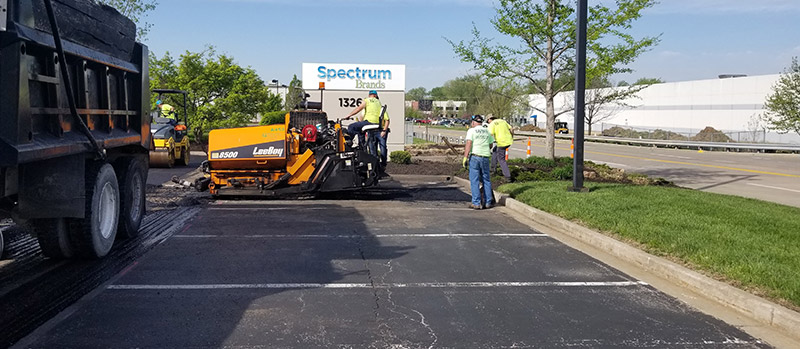The Best Guide To A1 Professional Asphalt & Sealing Llc
The Best Guide To A1 Professional Asphalt & Sealing Llc
Blog Article
The A1 Professional Asphalt & Sealing Llc PDFs
Table of ContentsLittle Known Facts About A1 Professional Asphalt & Sealing Llc.Rumored Buzz on A1 Professional Asphalt & Sealing LlcOur A1 Professional Asphalt & Sealing Llc StatementsIndicators on A1 Professional Asphalt & Sealing Llc You Need To KnowThe 3-Minute Rule for A1 Professional Asphalt & Sealing Llc

The oil in a cars and truck engine is not just oil. It contains a selection of additives to improve the car's performance. These consist of polymers, viscosity modifiers, warm stabilizers, extra lubricating substances, and wear ingredients. The REOB includes all the ingredients that remained in the waste oil as well as the wear steels from the engine (generally iron and copper).
By making lots of blends utilizing various REOB samples and various asphalt binders, the variants greatly can be balanced out. A number of States supplied samples of recognized REOB structure to TFHRC scientists, that assessed the examples to compare the portion of added (recognized) REOB to the found (examined) quantity. The analyses showed a similar portion of included and discovered REOB.
The smart Trick of A1 Professional Asphalt & Sealing Llc That Nobody is Talking About
They received a frustrating action. The TFHRC scientists evaluated 1,532 samples from 40 States, one Canadian district, and two Government Lands Freeway divisions. They examined each example twiceamounting to more than 3,000 analyses. None of those States understood that the asphalt they were getting consisted of REOB. One State insisted its examples had no REOB.
Of the 1,532 examples evaluated, 12 percent included REOB, and some consisted of substantially high degrees of it at 1020 percent. The greatest level was 34 percent in an example from Texas, which TxDOT had made use of in a patching substance. This testing likewise revealed the presence of phosphoric acid in 11 percent of the samples, and 2 percent contained ground tire rubber.
2 years ago at TRB's yearly conference, the Federal researchers held an REOB workshop and provided the searchings for of their laboratory analyses to a standing room-only group. Although some companies do not especially outlaw REOB, they do impose physical tests that preclude its useeffectively a restriction. a1 professional. Others do not outlaw it by spec, but have agreements with asphalt suppliers to prevent making use of REOB
The Only Guide to A1 Professional Asphalt & Sealing Llc
A handful do allow REOB, some within specific restrictions. For instance, Ohio and Texas limitation levels to much less than 5 percent of the asphalt. To establish a reputable examination approach that all States can utilize, the TFHRC researchers set up a round-robin test strategy. The individuals are 11 State freeway agencies (Illinois, Massachusetts, Minnesota, Mississippi, Montana, North Carolina, Oklahoma, South Carolina, Texas, Vermont, and Wyoming), 2 independent testing laboratories, the Ministry of Transportation in Ontario, Queen's College in Ontario, and an Ontario paving specialist.
In overall, the scientists prepared and delivered 720 blends. The individuals are examining the examples independently using the standards provided by the TFHRC researchers. The round-robin screening is nearly completed, and TFHRC is in the process of accumulating the results. The outcome will be a recommended AASHTO examination method that any kind of State can take on and make use of (a1 professional).
The sidewalk with REOB, which lies 0.6 mile (1 kilometer) from the pavement without REOB, has identical subgrade, web traffic thickness, and environment. Nonetheless, the sector of Highway655 with 5 to 10 percent REOB revealed substantial breaking. In this example, the visibility of REOB was the recognized reason for cracking at a low temperatures.
A section of examination sidewalk in Minnesota (MN1-4) view it now found to contain REOB additionally cracked too soon. The sidewalk performed well for the initial 3 to 4 years, but then started to crack.
The Facts About A1 Professional Asphalt & Sealing Llc Uncovered
The tests were not extensive, however they revealed that at levels of 6 percent or even more, the tensile strength of the asphalt went down substantially. At a degree of 3.5 percent REOB, the variation in the physical test techniques was greater than the impact of REOB. It was hard for scientists to examine whether REOB was existing. https://www.imdb.com/user/ur180438932/.

One binder criterion thought about is the distinction in between the low temperature essential spec temperature level for tightness (S) in the flexing beam rheometer and the bending light beam rheometer creep slope (m-value) noted as Tcritical. 2 independent study groups, one from AASHTO and the other from the Asphalt Institute, concluded that more research study is required on the usage of REOB in asphalt.
Previously, all asphalt testing gauged design homes such as tightness. These tests do not show what products had been included to the asphalt.

Excitement About A1 Professional Asphalt & Sealing Llc
These results show there are weak points in the standard design testing methods that may be exploited. The producer might have a financial benefit and the product passes all the standardized tests, yet the product may not be beneficial to making certain long-lasting efficiency. To address this problem and the development of brand-new asphalt additives and extenders, TFHRC is beginning a research program to utilize portable spectroscopic devices, x-ray fluorescence spectroscopy, and Fourier transform infrared spectroscopy to enable analyses to be performed in the area rather than having to take samples back to the laboratory.
Report this page